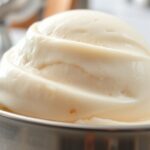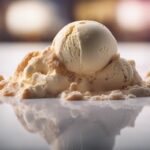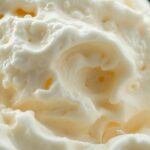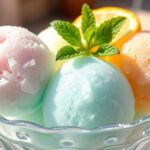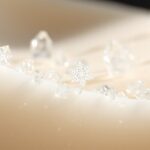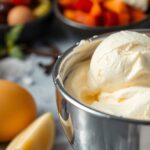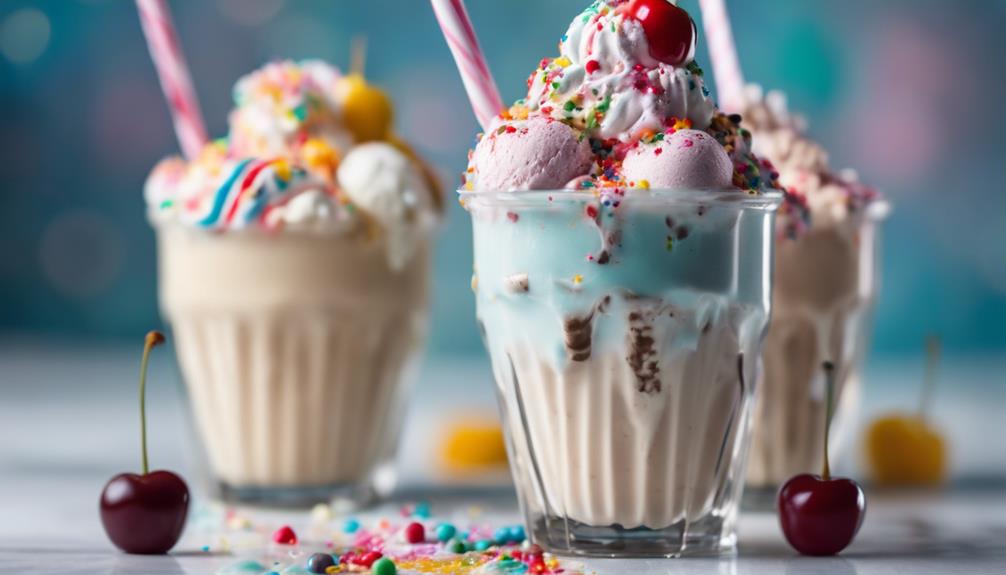Ever wondered why ice cream feels so soft and creamy? It’s all about the perfect mix of ingredients – emulsifiers like lecithin stop fats from clumping, keeping it smooth. Stabilizers like gelatin help too, by preventing big ice crystals. When churning adds air, it becomes light and airy. And freezing methods matter, creating fine crystals for that silky texture. The key to that delightful scoop is understanding air amounts, freezing rates, and the techniques used. So, next time you indulge in your favorite treat, remember, it’s all in the science behind that velvety smoothness!
Key Takeaways
- Emulsifiers prevent fat clumping, ensuring a smooth texture.
- Stabilizers like gelatin maintain creaminess by preventing large ice crystals.
- Air incorporation through whipping creates a light and airy texture.
- Proper balance of ingredients is crucial for softness and creaminess.
- Understanding fat crystallization and freezing techniques aids in soft texture development.
Ice Cream Emulsion and Texture
To achieve the soft and creamy texture of ice cream, it's important to understand the process of emulsifying fat into water, sugar, and air. Ice cream's delightful texture is a result of creating a stable emulsion where the fat droplets are evenly distributed throughout the mixture.
The emulsifiers present in ice cream, such as lecithin, play a pivotal role in preventing fat clumping and ensuring proper air incorporation. By incorporating air during the churning process, the ice cream gains its light and airy consistency, contributing to its soft texture.
Stabilizers like gelatin further enhance the texture by preventing large ice crystal formation and absorbing excess liquid. This helps maintain the smoothness and creaminess of the ice cream. The careful balance of ingredients, emulsifiers, and stabilizers in the ice cream recipe is what allows for the successful creation of a delectably soft and creamy treat.
Composition and Ingredients of Ice Cream
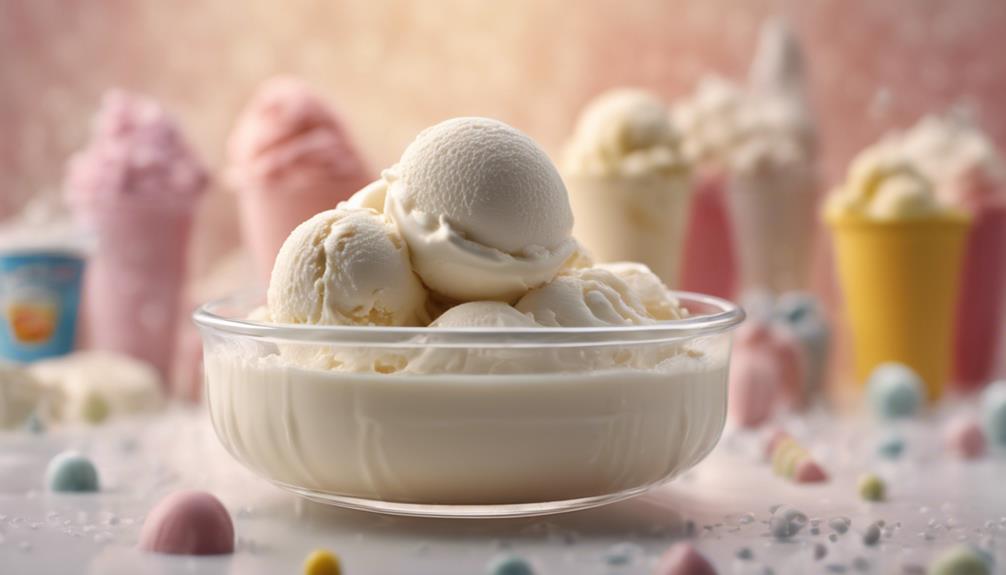
Understanding the composition and ingredients of ice cream is necessary for creating its desired texture and consistency.
Ice cream is a delightful mixture made up of ice crystals, air, fat, sweeteners, and various solids that combine to give it a unique texture. The size of ice crystals, air content, and fat content in ice cream are vital factors that determine its overall texture and consistency.
Emulsifiers such as lecithin and stabilizers like gelatin are added to prevent fat clumping, large crystal formation, and excess liquid in ice cream. Ingredients like milk products, egg yolks, and vegetable gums play a significant role in the emulsification, stabilization, and texture of ice cream.
Freeze Process and Texture Development
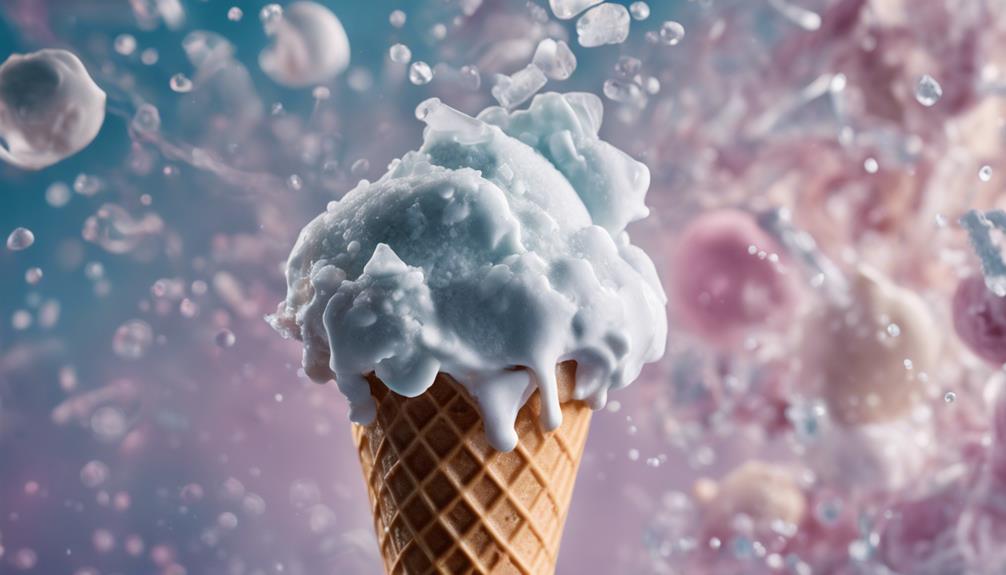
Air inclusion plays a pivotal role in contributing to the smooth and creamy consistency of ice cream during the freeze process. The freezing rate is pivotal as it impacts crystal formation, influencing the overall texture.
Utilizing appropriate freezing methods, such as liquid nitrogen or blast freezers, results in fine crystal formation, leading to a silkier texture. Factors like initial freezing rate and crystal growth are indispensable in determining the texture of ice cream.
The freeze process is fundamental in achieving the perfect balance of firmness and softness that defines the enjoyable texture of ice cream. By understanding the importance of air inclusion, freezing rate, and proper techniques, you can appreciate how texture development is intricately linked to the freeze process.
Mastering these elements guarantees that your ice cream maintains its smooth and creamy consistency, providing a delightful sensory experience with every scoop.
Factors Affecting Ice Cream Texture

Factors such as initial freezing speed play an important role in determining the texture of ice cream. When ice cream freezes slowly, larger ice crystals form, resulting in a less creamy texture.
Crystal formation during freezing is necessary for achieving the desired smooth and creamy texture in ice cream. Different freezing techniques, like using liquid nitrogen or blast freezers, can impact the size and structure of ice cream crystals, ultimately influencing its texture.
Liquid nitrogen is commonly utilized in ice cream machines to create small, fine crystals that contribute to a smoother mouthfeel. By controlling factors such as the speed of freezing, crystal growth, and freezing techniques, ice cream makers can manipulate the overall texture of the final product.
These considerations are essential for ensuring that your favorite frozen treat is velvety and delightful with every scoop.
Fat Crystallization in Ice Cream
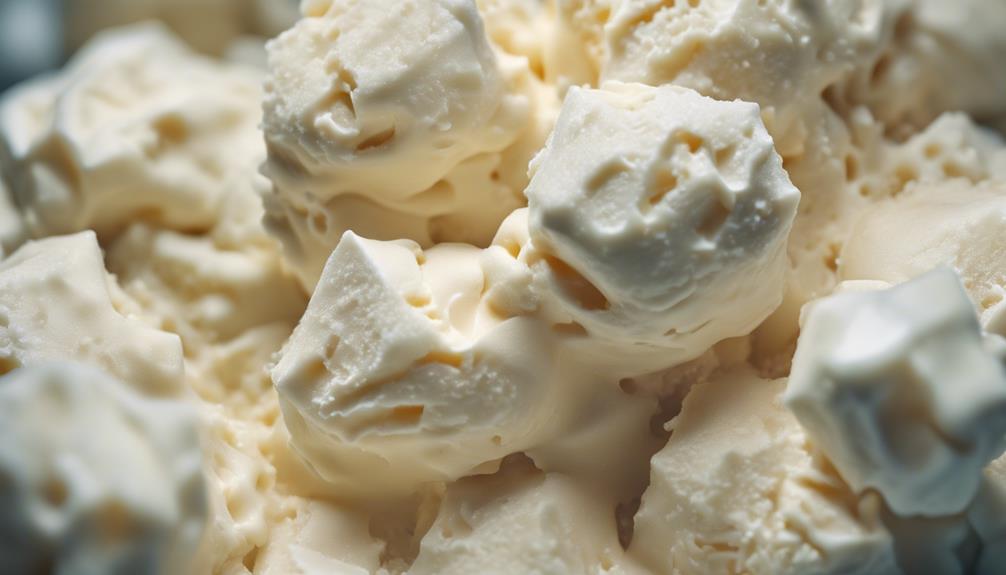
When making ice cream, the process of fat crystallization plays an essential role in determining its texture. Different types of fat crystals, like alpha, beta prime, and beta, form during this process and greatly impact the final product's mouthfeel.
Understanding how fat crystals nucleate and grow is key to achieving the desired smooth and creamy texture in your ice cream.
Fat Crystal Formation
Understanding the process of fat crystal formation in ice cream is necessary for achieving the desired texture, mouthfeel, and flavor of the frozen treat. Fat crystals play a pivotal role in determining the overall quality of ice cream.
The process begins with supercooling the ice cream base, followed by nucleation where the formation of tiny crystalline structures initiates. As the ice cream is churned and frozen, these fat crystals grow in size and re-crystallize into different forms such as alpha, beta prime, and beta crystals, influencing the texture and mouthfeel of the final product.
Factors like the fat content of the base, the presence of emulsifiers, the churning speed, temperature control during freezing, and the saturation levels all impact the formation of fat crystals. Understanding and controlling fat crystal formation is crucial for producing ice cream with a smooth, creamy texture that delights your taste buds.
Nucleation Process
The nucleation process in fat crystallization within ice cream involves the supercooling and initial clustering of fat molecules. This process is pivotal in determining the final texture and consistency of the frozen treat. When fat molecules cool below the freezing point without solidifying, they undergo supercooling, forming the basis for crystal formation. The clustering of fat molecules initiates the growth of crystals, leading to the desired smooth texture in ice cream. Various factors such as the fat content, presence of emulsifiers, churning techniques, and temperature play significant roles in influencing the nucleation process.
| Nucleation Process | Impact on Ice Cream Texture |
|---|---|
| Supercooling | Smooth and Creamy Texture |
| Clustering | Consistent and Even Consistency |
| Emulsifiers | Enhanced Creaminess |
| Churning Techniques | Control Over Crystal Size |
Impact on Texture
Fat crystallization in ice cream greatly influences the overall sensory experience, including texture and mouthfeel, creating a delightful treat loved by many. The process of fat crystallization involves various stages like nucleation, crystal growth, and re-crystallization, all of which significantly impact the final texture of the ice cream.
Different types of fat crystals, such as alpha, beta prime, and beta, play a crucial role in determining how smooth, creamy, and rich the ice cream feels in your mouth. Factors like fat content, presence of emulsifiers, churning technique, and temperature control all affect fat crystallization in ice cream, ultimately influencing the quality of the frozen dessert.
- Fat crystallization stages influence texture and mouthfeel.
- Different types of fat crystals impact the creaminess of ice cream.
- Factors like fat content and emulsifiers affect fat crystallization.
- Understanding fat crystallization is essential for achieving desired ice cream texture.
Types and Myths of Ice Cream

Several types of ice cream exist, each with its own unique characteristics and flavors. Frozen custard sets itself apart by containing at least 1.4% egg yolks, offering a smoother consistency than traditional ice cream.
On the other hand, frozen yogurt is often perceived as a healthier option due to its lower fat and calorie content compared to regular ice cream. Soft-serve ice cream, known for its lighter texture, is created with less fat and more air during the churning process.
When it comes to ice cream myths, stories like Martha Washington's supposed 1782 discovery contribute to the folklore surrounding its origins. In the production of ice cream, stabilizers like guar gum and xanthan gum are commonly used to enhance texture and prevent crystal formation.
Understanding the distinctions between these various types of ice cream can help you choose the perfect treat to satisfy your cravings.
Ice Cream Production Techniques
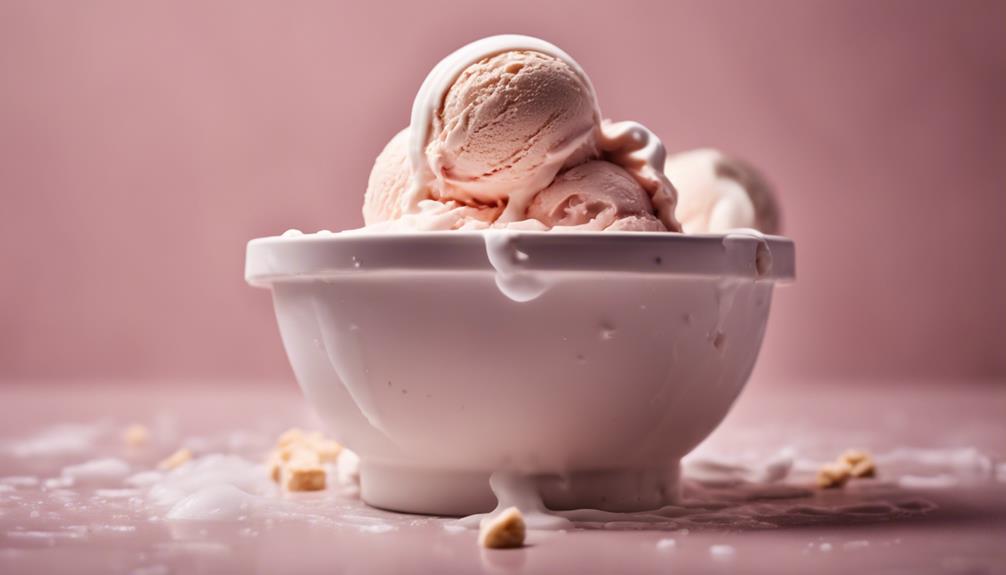
Ice cream production techniques involve whipping the mixture to introduce air bubbles. This process helps create a light and airy texture that's characteristic of well-made ice cream. The freeze step in ice cream production is critical as it allows for the formation of smaller ice crystals, resulting in a smoother texture.
Emulsifiers like lecithin play a role in preventing fat clumping and ensuring proper air incorporation. Stabilizers such as gelatin are also added to ice cream to prevent the formation of large ice crystals, maintaining a creamy consistency.
The science behind these techniques focuses on the precise balance of ingredients like fat, air, sweeteners, and stabilizers to create the perfect ice cream texture that we all love.
Frequently Asked Questions
What Gives Ice Cream Its Soft Texture?
Ice cream gets its soft texture from the air whipped in during freezing. The amount of air added, called overrun, affects the creaminess. Premium brands have less air, making them denser and creamier, while cheaper ones are lighter.
Why Is Ice Cream Always Soft?
Ice cream is always soft because of its unique composition with air bubbles and emulsifiers. The incorporation of air during freezing helps maintain its creamy texture. Premium brands with high fat content and low overrun stay soft and creamy.
What Is the Science Behind Why We Love Ice Cream?
You love ice cream thanks to its perfect blend of fat, sugar, air, and ice. The emulsion of fat in water guarantees a creamy texture. Sweeteners prevent iciness, and factors like ice crystal size and air content contribute to its firm yet soft feel.
Why Is Soft Ice Cream so Good?
Soft ice cream is so good for its creamy, smooth texture that easily melts in your mouth. The light and fluffy consistency, lower fat content, and smoother texture from slow churning make it a delightful treat.
What Causes Ice Cream to Have a Soft Texture, and Can It Be Used in Waffle Cones?
The soft texture of delicious waffle cone ice cream combo is due to the high fat content and air whipped into the mixture. This allows the ice cream to stay creamy even when frozen. While it can be used in waffle cones, it’s important to consider the structural integrity of the cone.
Conclusion
So next time you enjoy a scoop of your favorite ice cream, remember that its soft and creamy texture is a result of the intricate science behind its emulsion, composition, freezing process, and fat crystallization.
And don't believe the myths – whether it's gelato, soft serve, or traditional churned ice cream, they all have their unique textures that make them delicious in their own way.
Keep enjoying your favorite frozen treat and appreciate the science that makes it so enjoyable!


